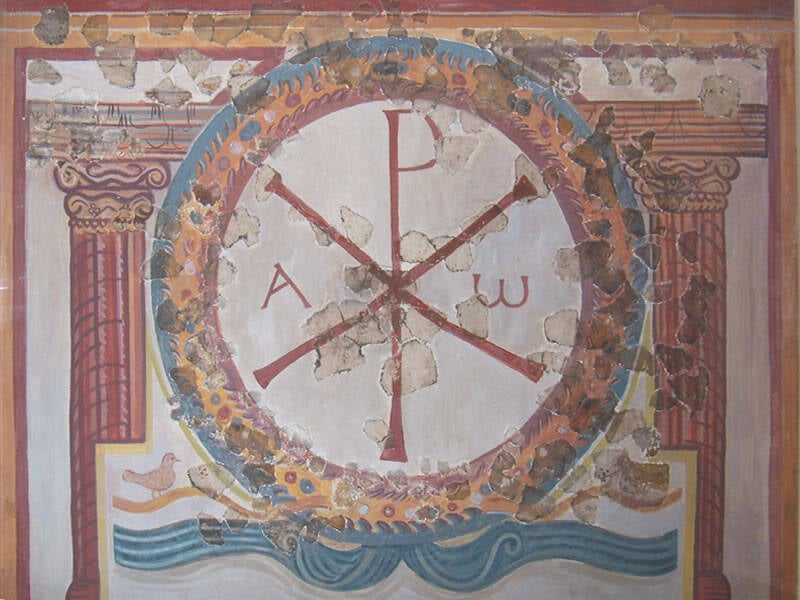Dating to the seventh or eighth century C.E., the tattoo combines the Greek letters chi and rho in an abbreviation for the word "Christ."

Kari A. GuilbaultThe tattoo’s location may have significance, as it’s in the spot where nails were allegedly driven through Jesus Christ’s feet.
Kari Guilbault was preparing to photograph the remains of a 1,300-year-old body discovered at the Ghazali archaeological site in Sudan when she noticed a mark on the corpse’s right foot. Guilbault, a bioarchaeologist at Purdue University, took a closer look — and realized that the mark was actually a tattoo that referenced Jesus Christ.
“It was quite a surprise to all of a sudden see what appeared to be a tattoo when I was working with the Ghazali collection,” Guilbault said in a statement from the Polish Centre of Mediterranean Archaeology (PCMA) at the University of Warsaw. She continued: “At first, I was not certain, but when the images were processed and the tattoo was clearly visible, any initial uncertainties were removed.”
As the PCMA statement explains, the small tattoo contains the “Chi-Rho” symbol, an abbreviation for Christ that first appeared around 324 C.E., as well as the Greek letters alpha and omega. These letters, as the first and last letters of the Greek alphabet, “stand for the Christian belief that god is the beginning and the end of everything.”

Udimu/British Museum/Wikimedia CommonsJust like the tattoo, this restored fresco from England depicts the Chi-Rho symbol as well as the Greek letters alpha and omega.
The tattoo is just the second found from medieval Nubia (which spread across modern-day Egypt and Sudan) and is thus an exciting discovery. Guilbault explained that the tattoo differs from other early tattoos from the region in that it uses straight lines instead of a “dot and dash” technique.
And experts have some ideas of what it meant to the person who got it.
According to Guilbault and Robert Stark, a bioarchaeologist with PCMA, the placement of the tattoo on the body’s right foot could be a nod to the crucifixion of Jesus Christ, as Roman soldiers allegedly drove nails through his hands and feet as they affixed him to the cross.
Stark further suggested to the Daily Mail that the placement of the tattoo suggested that it had private rather than public meaning, as it would have been most visible to its owner. That said, Christianity was widely practiced in the region at the time that this individual was alive.
“One of the big questions is how can we tell someone was religious and this is one of those tangible markers of their Christian faith,” Guilbault explained to the Daily Mail. “This is a really fine example of how a person’s faith was a part of their life and their body.”
As the PCMA statement explains, the body of the individual — believed to be a man — was discovered during a larger excavation of the Ghazali archaeological site between 2012 and 2018. During that time, the archaeological team investigated a medieval Christian monastery as well as four nearby cemeteries and hundreds of graves.

Public DomainThe ruins of a monastery at the Ghazali archaeological site, as depicted in a 19th-century painting.
The individual with the tattoo was not buried with the monastery’s monks but in a cemetery that was perhaps used by people living in the surrounding communities. They lived sometime between 667 and 774 and likely died between the ages of 35 and 50. That said, it’s unclear if the person with the tattoo was a monk or not.
Nor is it clear how they got their tattoo in the first place. The Daily Mail reported that the tattoo was preserved because the arid conditions of Sudan partially mummified its owner. But the remains are so fragile that taking a sample from the tattoo to determine its provenance would destroy it.
As such, there’s still a lot for archaeologists to learn about the body with the Christ tattoo and what such an image would have meant at the time.
“Documentation of this tattoo from Ghazali,” the PCMA statement notes, “brings forth numerous questions about the practice of tattooing and signs of faith in medieval Nubia.”
After reading about the body discovered in Sudan with a Christ tattoo, see how a 2,000-year-old “tattoo gun” found in Utah was identified as the oldest tool ever discovered in North America. Or, discover how archaeologists came across the world’s oldest known tattoo needles in Tennessee.





